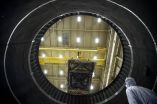(Press-News.org) ITHACA, N.Y. – For the first time, a team of interdisciplinary researchers have made recordings of neurons associated with visual perception inside the poppy seed-sized brain of a jumping spider (Phidippus audax).
Video: http://www.cornell.edu/video/vision-in-jumping-spiders/s252/e552
Though neurobiologists have tried for half a century to better understand the brains of jumping spiders, no one has succeeded. The liquid in spiders' bodies is pressurized, as they move with hydraulic pressure and muscles, so they don't tolerate previous research techniques.
As a result, the research team tried a different strategy: make a very tiny hole that self-seals around a hair-sized tungsten recording electrode.
"The team, together for almost two years now, had to pull together as a collective on every aspect of the work, from designing experiments, writing programs, performing statistical analysis, doing brain surgery, to writing the papers," said Ron Hoy, professor of neurobiology and behavior at Cornell University and the senior author of the study published this month in an early online edition of Current Biology. "No one or two of them, without the others, could have pulled off this formidable challenge," he added.
Study: http://www.sciencedirect.com/science/article/pii/S0960982214011506
Gil Menda, a postdoctoral researcher in Hoy's lab and the paper's first author, recognized that if a hole was small enough, the spider's self-sealing properties could close a cut. He used steady hands to insert microelectrodes into the spider's brain and record electrical spikes from neurons in its visual processing networks.
Jumping spiders have unique visual systems that have a nearly 360 degree panoramic view. They also have a pair of large, specialized front-facing eyes that are almost as acute as human eyes. This visual system supports the spider's cat-like hunting behavior; it stealthily stalks and pounces on its prey. Unlike most other spiders, jumping spiders don't build webs, but hunt nomadically like cats instead.
Menda and colleagues used a 3-D printer to construct a tiny harness for the spider, to hold it in place, and they made even smaller blinders to cover certain eyes while leaving others exposed. With the inserted microelectrode, Menda recorded bursts of activity from individual neurons when an image of a fly, the spider's natural prey, was projected moving across a screen.
A jumping spider's unique visual system permits them to use different sets of eyes to process acuity and motion, requiring the spider to integrate inputs from different sets of eyes in the brain in a nonlinear manner. The researchers learned that when one set of eyes was open and another set was covered, there was little response in the visual processing parts of the brain when a stimulus was projected on a LCD screen. When different sets of eyes were open together, the same image elicited neural activity. "It needs all the eyes open for the brain to process information," said co-author Paul Shamble, a graduate student in Hoy's lab who specializes in spiders.
"Usually, you know what you are getting into, but a spider's brain is so small, we couldn't," said co-author Eyal Nitzany, a graduate student in the field of biological statistics and computational biology. "We put the electrode in, and then we had to verify what we were getting into."
The study provides clues for the first time into how a jumping spider's brain processes information and opens up a new field of basic neuroscience, Hoy said. The work could also be applied to optical sensor technology: "Researchers are always interested in miniaturizing biosensors – and jumping spiders have really tiny eyes," Shamble said.
"In the modern age, animals like this are smarter than robots," said co-author James Golden, who has a master's in electrical engineering from Cornell and is a doctoral student in the field of psychology interested in robotics and optical systems. "Jumping spiders have been this little black box of behaviors. We can now investigate how these things happen."
INFORMATION:
The study was funded by the National Institutes of Health and the Tri-Institutional Training Program in Computational Biology and Medicine.
Patients diagnosed with high blood pressure are given better control of their condition from a physician-pharmacist collaborative intervention than physician management alone, according to new research.
Pharmacists can play a key role in communicating with physicians to address suboptimal therapy, helping physicians to provide counselling on lifestyle change and performing patient follow-up.
The research was carried out to evaluate the individual care processes of the physician-pharmacist collaborative intervention in treating hypertension, a major cause of heart disease, ...
CHAPEL HILL, NC – UNC School of Medicine researchers have pinpointed a set of intriguing characteristics in a previously unknown subpopulation of melanoma cancer cells in blood vessels of tumors. These cells, which mimic non-cancerous endothelial cells that normally populate blood vessels in tumors, could provide researchers with another target for cancer therapies.
The research, published today in the journal Nature Communications, provides evidence for how these particular melanoma cells help tumors resist drugs designed to block blood vessel formation.
"For ...
Those who self-harm as teenagers are more at risk of developing mental health and substance misuse problems as adults, new research from the biggest study of its kind in the UK has revealed.
Researchers at the University of Bristol, working together with colleagues from the University of Oxford and University College London, collected data from 4,799 adolescents as part of Children of the 90s - one of the world's largest population studies - to examine the outcomes of self-harm for the first time.
The research paper, funded by the Medical Research Council and published ...
When a toddler takes their first steps we observe an uncertain sway in their walking. Being unsteady on our feet is something we can experience throughout life – and a new study has shown how even the lightest fingertip touch can help people to maintain their balance.
The research, led by the University of Birmingham, explains how neural and mechanical mechanisms synchronize our sway with another person.
Dr Raymond Reynolds explained, "There's something very human, very instinctive, that makes us reach out and grab something or someone when we're unsure of our ...
The search for blood-borne biomarkers that could be used to screen for colorectal cancer (CRC) has uncovered two promising candidates that may one day lead to the development of a simple blood test. Scientists have been piecing together the molecular events involved in the development of CRC and have identified abnormal DNA methylation patterns and the presence of microRNAs as major players in the carcinogenic process.
Speaking to journalists today at the 22nd United European Gastroenterology Week (UEG Week 2014) in Vienna, Austria, Dr Antoni Castells from the Institute ...
Rates of type 1 diabetes—the autoimmune form of the condition that often begins in childhood and eventually results in lifelong dependency on insulin—are increasing in almost all nations worldwide. However, while it appears possible from research in other forms of diabetes that physical exercise could slow the progression of this disease, there have been no studies to date that explore this in patients with type 1 diabetes. In a paper published in Diabetologia (the journal of the European Association for the Study of Diabetes) researchers argue that such trials ...
Researchers at Emory University School of Medicine have identified a protein released by neurons while the brain is recovering from a stroke.
The results are scheduled for publication Oct. 21 in Journal of Neuroscience.
The protein, called urokinase-type plasminogen activator or uPA, has been approved by the FDA to dissolve blood clots in the lungs. It has been tested in clinical trials in some countries as a treatment for acute stroke.
The Emory team's findings suggest that in stroke, uPA's benefits may extend beyond the time when doctors' principal goal is dissolving ...
After 116 days of being subjected to extremely frigid temperatures like that in space, the heart of the James Webb Space Telescope, the Integrated Science Instrument Module (ISIM) and its sensitive instruments, emerged unscathed from the thermal vacuum chamber at NASA's Goddard Space Flight Center in Greenbelt, Maryland.
Teams of engineers and technicians have been on heart-monitoring duty around the clock since this complicated assembly was lowered into the chamber for its summer-long test.
Engineer Mike Drury, the ISIM Lead Integration and Test Engineer, is one ...
College Park, Md. - The supply chain is ground zero for several recent cyber breaches. Hackers, for example, prey on vendors that have remote access to a larger company's global IT systems, software and networks.
In the 2013 Target breach, the attacker infiltrated a vulnerable link: a refrigeration system supplier connected to the retailer's IT system.
A counter-measure, via a user-ready online portal, has been developed by researchers in the Supply Chain Management Center at the University of Maryland's Robert H. Smith School of Business.
The portal is based on ...
Question: When does a Tropical Cyclone drop snowfall?
Answer: When it makes landfall in India and the moisture moves over the Himalayas as Cyclone Hudhud has done. When NASA's Aqua satellite passed over the Himalayan Mountains, the MODIS instrument captured this image of snow on the ground on Oct. 16 at 0705 UTC (3:50 a.m. EDT). Cyclone Hudhud made landfall in eastern India and moved over the Himalayas dropping snowfall in Nepal and southwestern China.
INFORMATION:
Rob Gutro
NASA's Goddard Space Flight Center
...



